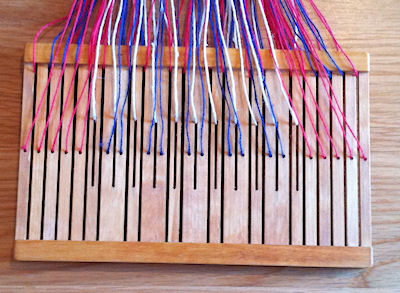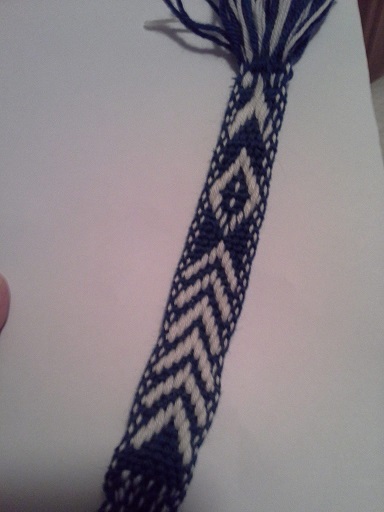Difference between revisions of "Backstrap loom"
(Text body) |
(more info about history and pictures) |
||
| Line 2: | Line 2: | ||
Backstrap loom is a simple loom which has its roots in ancient civilizations. Modern day looms include a rigid heddle. And many include a frame to which the warp yarns and sometimes even the heddle is fixed. I'm going to make a more traditional piece with only very few parts and using weavers body as a way to tension the warp yarns. | Backstrap loom is a simple loom which has its roots in ancient civilizations. Modern day looms include a rigid heddle. And many include a frame to which the warp yarns and sometimes even the heddle is fixed. I'm going to make a more traditional piece with only very few parts and using weavers body as a way to tension the warp yarns. | ||
| + | |||
| + | <gallery> | ||
| + | File:antique heddle 1.jpg |Antique heddle | ||
| + | File:round heddles.jpg |Round heddles. This shape intrigues me. | ||
| + | </gallery> | ||
| + | |||
| + | Then there is the "fishtail" loom that is used to make more complex designs more easily than with normal loom. | ||
| + | |||
| + | [[File:fishtail loom.jpg]] This one has some shorter slots for pattern picking. | ||
| + | |||
| + | [[File:fishtale tape.jpg]] Pattern picking tape I made at home. | ||
== My experiences == | == My experiences == | ||
| − | I´m only starting to experiment with using belt loom and so far I've noticed that a wider belt is needed. Because thin belt digs too deep and is painful. Also the shuttle design is critical for easy making of the woollen ribbon. There are several kinds of shuttle designs and it would be wise to experiment with three or four types before settle for a design. | + | I´m only starting to experiment with using belt loom and so far I've noticed that a wider belt is needed. Because thin belt digs too deep and is painful. Also the shuttle design is critical for easy making of the woollen ribbon. There are several kinds of shuttle designs and it would be wise to experiment with three or four types before settle for a design. It deeds to have a tapered edge for "beating" the weft yarns tight enough. |
| + | |||
| + | The old wooden loom that I have back home is just too heavy. It requires high amount of tension just to operate. And it's too top heavy, it tends to topple over the warp yarns a lot. I want to achieve light enough loom that is still strong enough to work for a long time. | ||
=== Parts === | === Parts === | ||
| Line 15: | Line 28: | ||
<gallery> | <gallery> | ||
| − | File:Using loom.jpg | | + | File:Using loom.jpg |The way loom is traditionally used in Finland. |
File:Waist holding point2.jpg |Holder I´d like to make. I like the idea that everything would be hold in place by leaning back, not with extra fastening. | File:Waist holding point2.jpg |Holder I´d like to make. I like the idea that everything would be hold in place by leaning back, not with extra fastening. | ||
optional%20threading%20station.jpg |Optional threading station. This would be really helpful thing to have. | optional%20threading%20station.jpg |Optional threading station. This would be really helpful thing to have. | ||
</gallery> | </gallery> | ||
Revision as of 16:08, 11 February 2016
History
Backstrap loom is a simple loom which has its roots in ancient civilizations. Modern day looms include a rigid heddle. And many include a frame to which the warp yarns and sometimes even the heddle is fixed. I'm going to make a more traditional piece with only very few parts and using weavers body as a way to tension the warp yarns.
Then there is the "fishtail" loom that is used to make more complex designs more easily than with normal loom.
 This one has some shorter slots for pattern picking.
This one has some shorter slots for pattern picking.
 Pattern picking tape I made at home.
Pattern picking tape I made at home.
My experiences
I´m only starting to experiment with using belt loom and so far I've noticed that a wider belt is needed. Because thin belt digs too deep and is painful. Also the shuttle design is critical for easy making of the woollen ribbon. There are several kinds of shuttle designs and it would be wise to experiment with three or four types before settle for a design. It deeds to have a tapered edge for "beating" the weft yarns tight enough.
The old wooden loom that I have back home is just too heavy. It requires high amount of tension just to operate. And it's too top heavy, it tends to topple over the warp yarns a lot. I want to achieve light enough loom that is still strong enough to work for a long time.
Parts
-Rigid heddle -Shuttle -Belt -Some sort of holder between warp yarns and belt (-Threading station)



